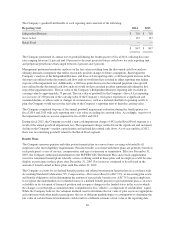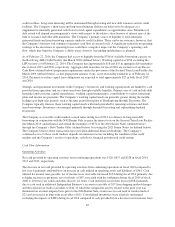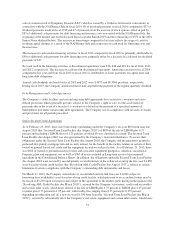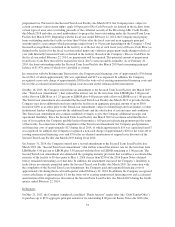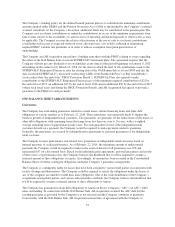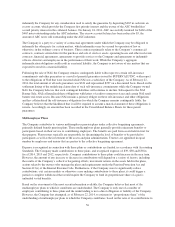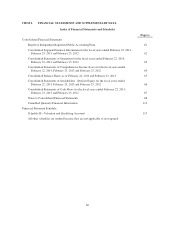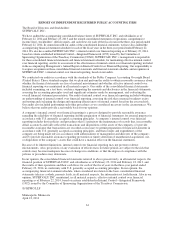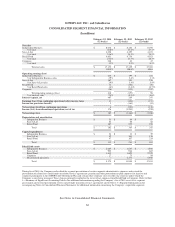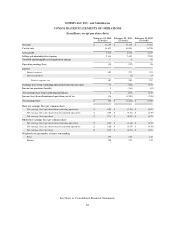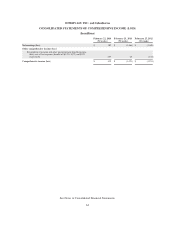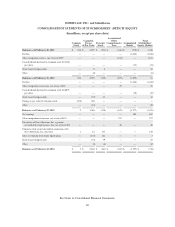Albertsons 2014 Annual Report Download - page 58
Download and view the complete annual report
Please find page 58 of the 2014 Albertsons annual report below. You can navigate through the pages in the report by either clicking on the pages listed below, or by using the keyword search tool below to find specific information within the annual report.indemnify the Company for any consideration used to satisfy the guarantee by depositing $467 in cash into an
escrow account, which provides the Company first priority interest and the trustee of the ASC bondholders’
second priority interest in the collateral balance. On January 24, 2014, ASC successfully tendered for $462 of the
$467 notes outstanding under the ASC indenture. The escrow account balance has been reduced to $5, the
amount of ASC notes still outstanding under the ASC indenture.
The Company is a party to a variety of contractual agreements under which the Company may be obligated to
indemnify the other party for certain matters, which indemnities may be secured by operation of law or
otherwise, in the ordinary course of business. These contracts primarily relate to the Company’s commercial
contracts, contracts entered into for the purchase and sale of stock or assets, operating leases and other real estate
contracts, financial agreements, agreements to provide services to the Company and agreements to indemnify
officers, directors and employees in the performance of their work. While the Company’s aggregate
indemnification obligation could result in a material liability, the Company is not aware of any matters that are
expected to result in a material liability.
Following the sale of NAI, the Company remains contingently liable with respect to certain self-insurance
commitments and other guarantees as a result of parental guarantees issued by SUPERVALU INC. with respect
to the obligations of NAI that were incurred while NAI was a subsidiary of the Company. As of February 22,
2014, the total amount of all such guarantees was $331 and represented $297 on a discounted basis. Based on the
settlement listing of the underlying claims data of such self-insurance commitments while the Company owned
NAI, the Company believes that such contingent liabilities will continue to decline. Subsequent to the NAI
Banner Sale, NAI collateralized these obligations with letters of credit to numerous states and certain NAI retail
banner real estate assets. Because NAI remains a primary obligor on these self-insurance and other obligations
and has collateralized the self-insurance obligations for which the Company remains contingently liable, the
Company believes that the likelihood that it will be required to assume a material amount of these obligations is
remote. Accordingly, no amount has been recorded in the Consolidated Balance Sheets for these parent
guarantees.
Multiemployer Plans
The Company contributes to various multiemployer pension plans under collective bargaining agreements,
primarily defined benefit pension plans. These multiemployer plans generally provide retirement benefits to
participants based on their service to contributing employers. The benefits are paid from assets held in trust for
that purpose. Plan trustees typically are responsible for determining the level of benefits to be provided to
participants as well as the investment of the assets and plan administration. Trustees are appointed in equal
number by employers and unions that are parties to the collective bargaining agreement.
Expense is recognized in connection with these plans as contributions are funded, in accordance with Accounting
Standards. The Company made contributions to these plans, and recognized expense, of $39, $38 and $38 in
fiscal 2014, 2013 and 2012, respectively. Company contributions to these plans could increase in the near term.
However, the amount of any increase or decrease in contributions will depend on a variety of factors, including
the results of the Company’s collective bargaining efforts, investment returns on the assets held in the plans,
actions taken by the trustees who manage the plans and requirements under the Pension Protection Act and
Section 412(e) of the Internal Revenue Code. Furthermore, if the Company were to significantly reduce
contributions, exit certain markets or otherwise cease making contributions to these plans, it could trigger a
partial or complete withdrawal that would require the Company to fund its proportionate share of a plan’s
unfunded vested benefits.
Based on the assessment of the most recent information available, the Company believes that most of the
multiemployer plans to which it contributes are underfunded. The Company is only one of a number of
employers contributing to these plans and the underfunding is not a direct obligation or liability of the Company.
However, the Company has attempted, as of February 22, 2014, to estimate its “proportionate share” of the
underfunding of multiemployer plans to which the Company contributes, based on the ratio of its contributions to
56


